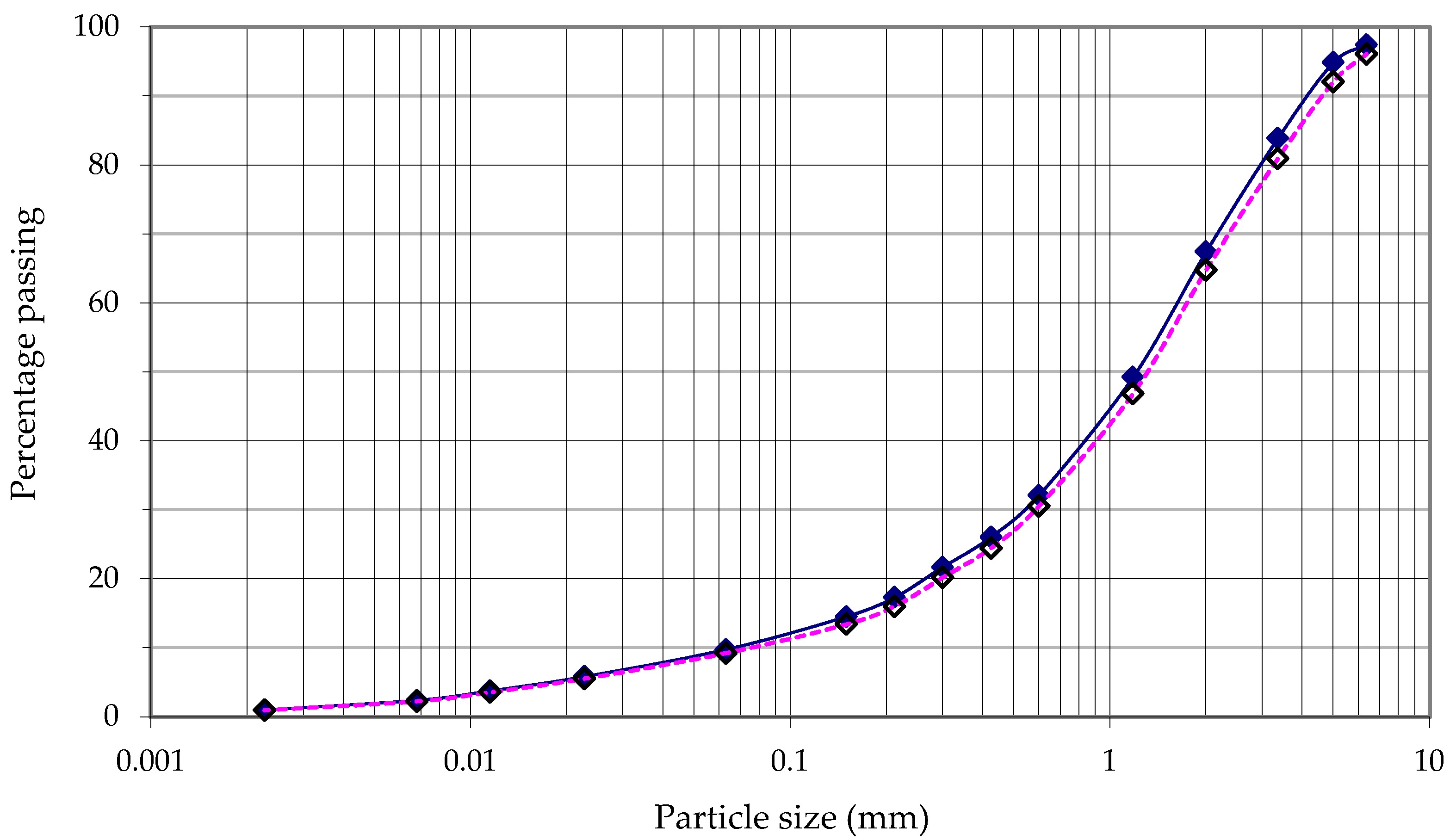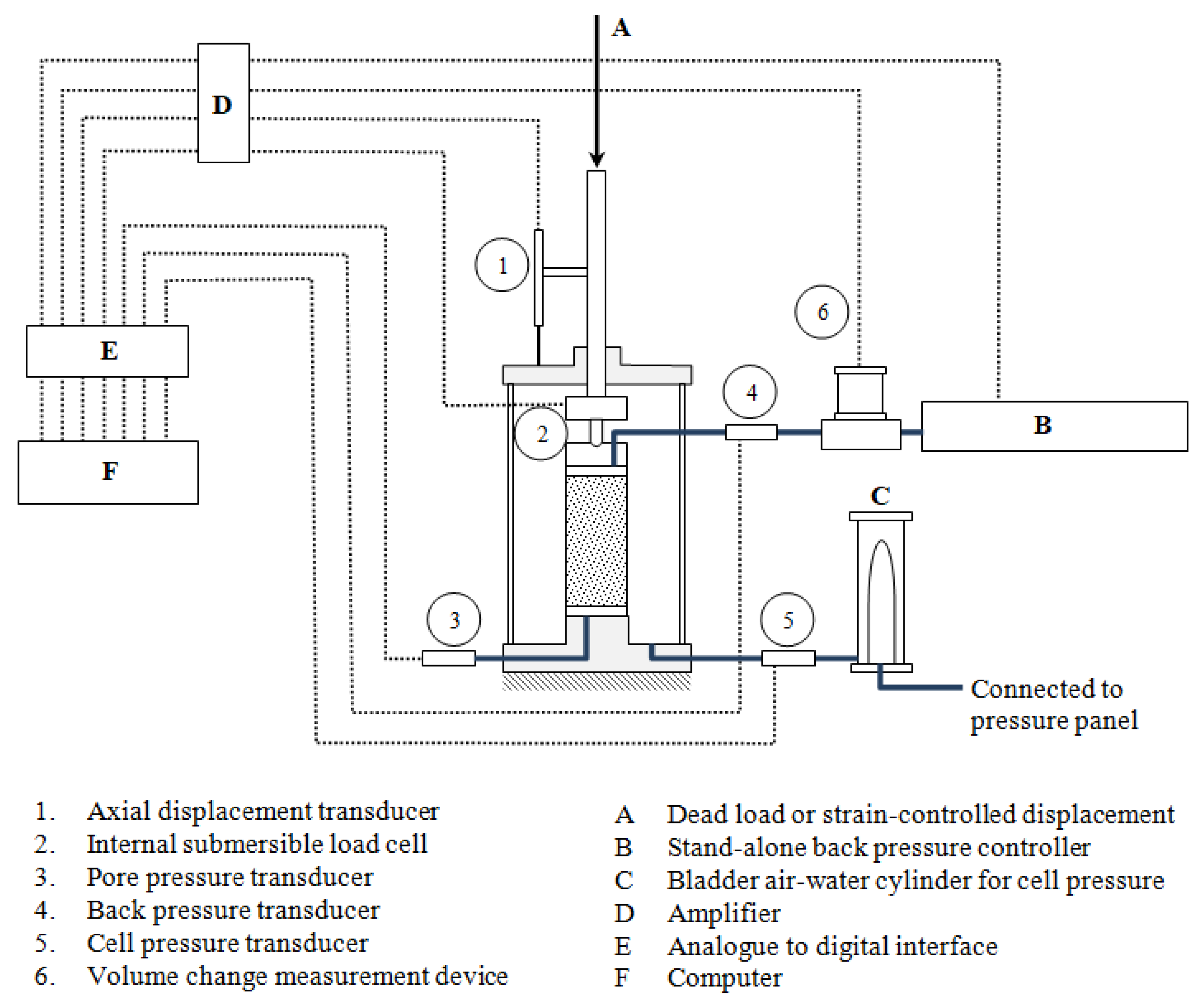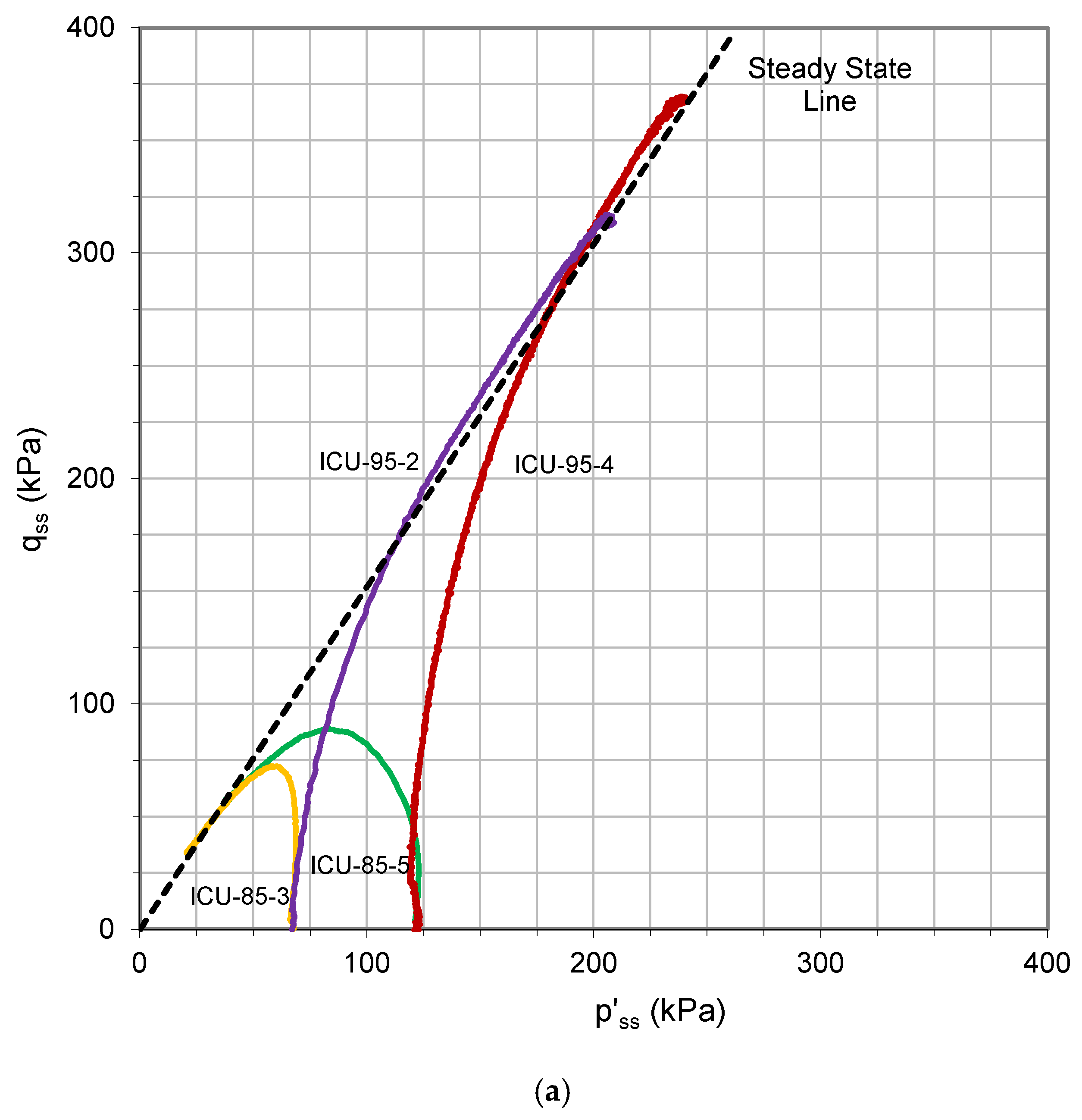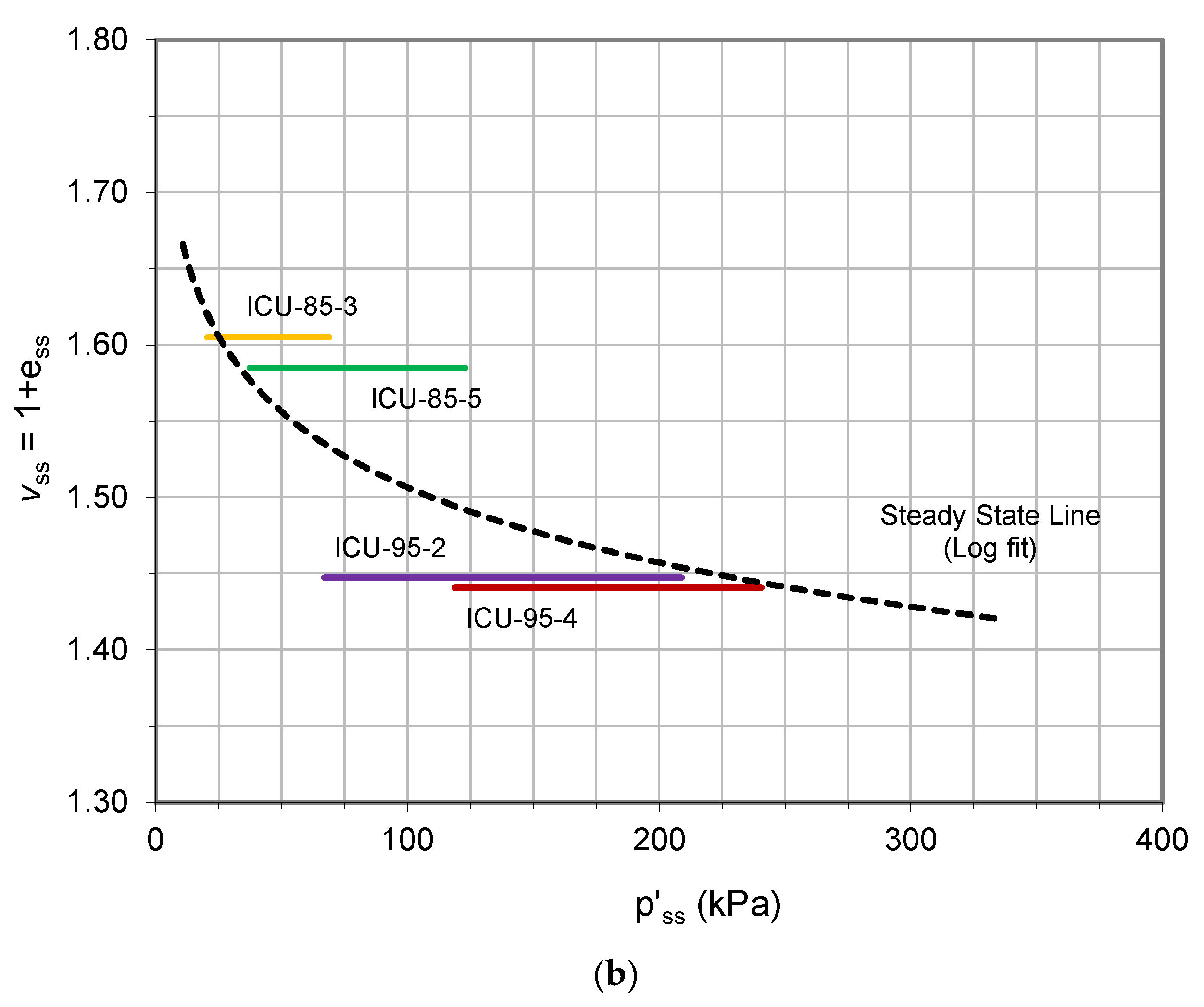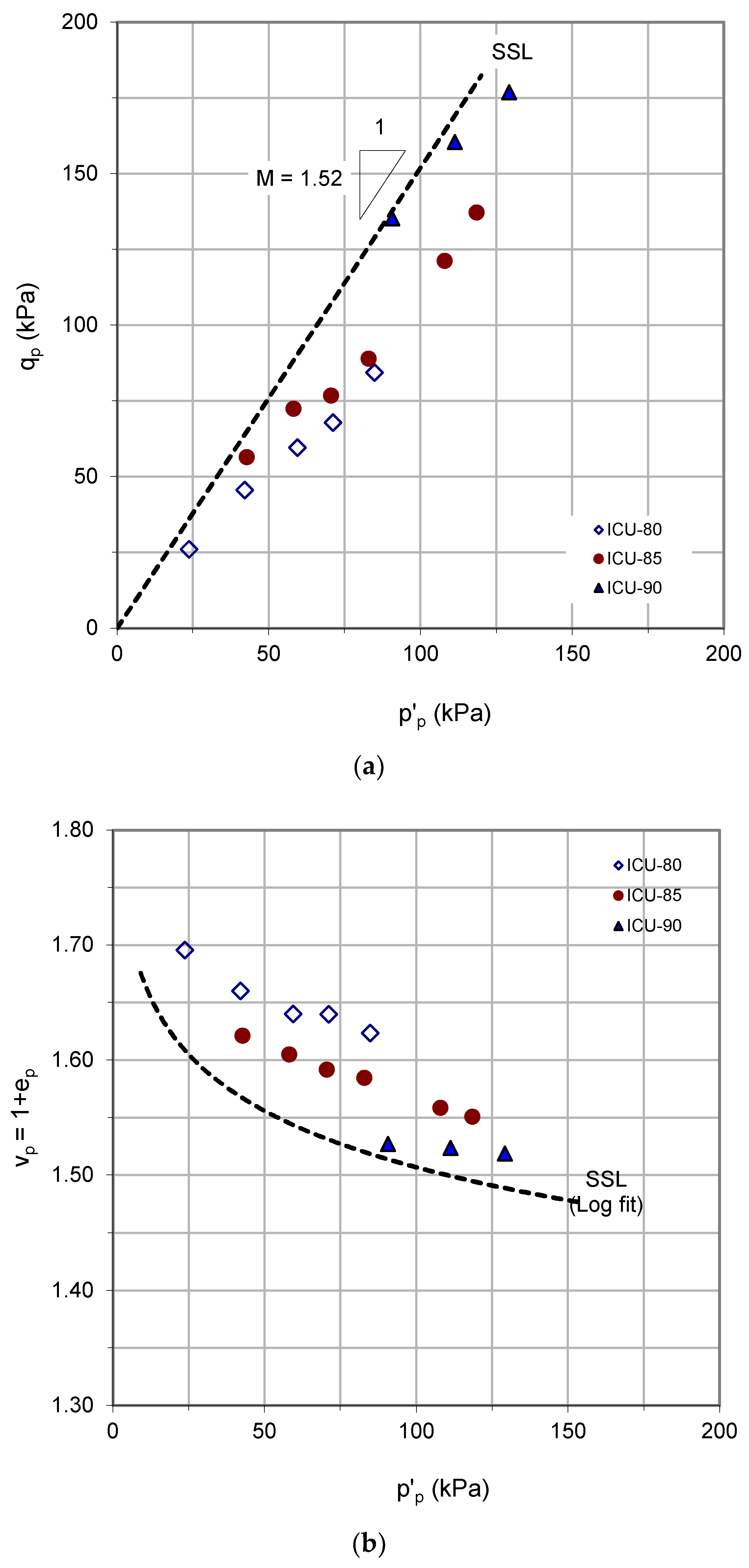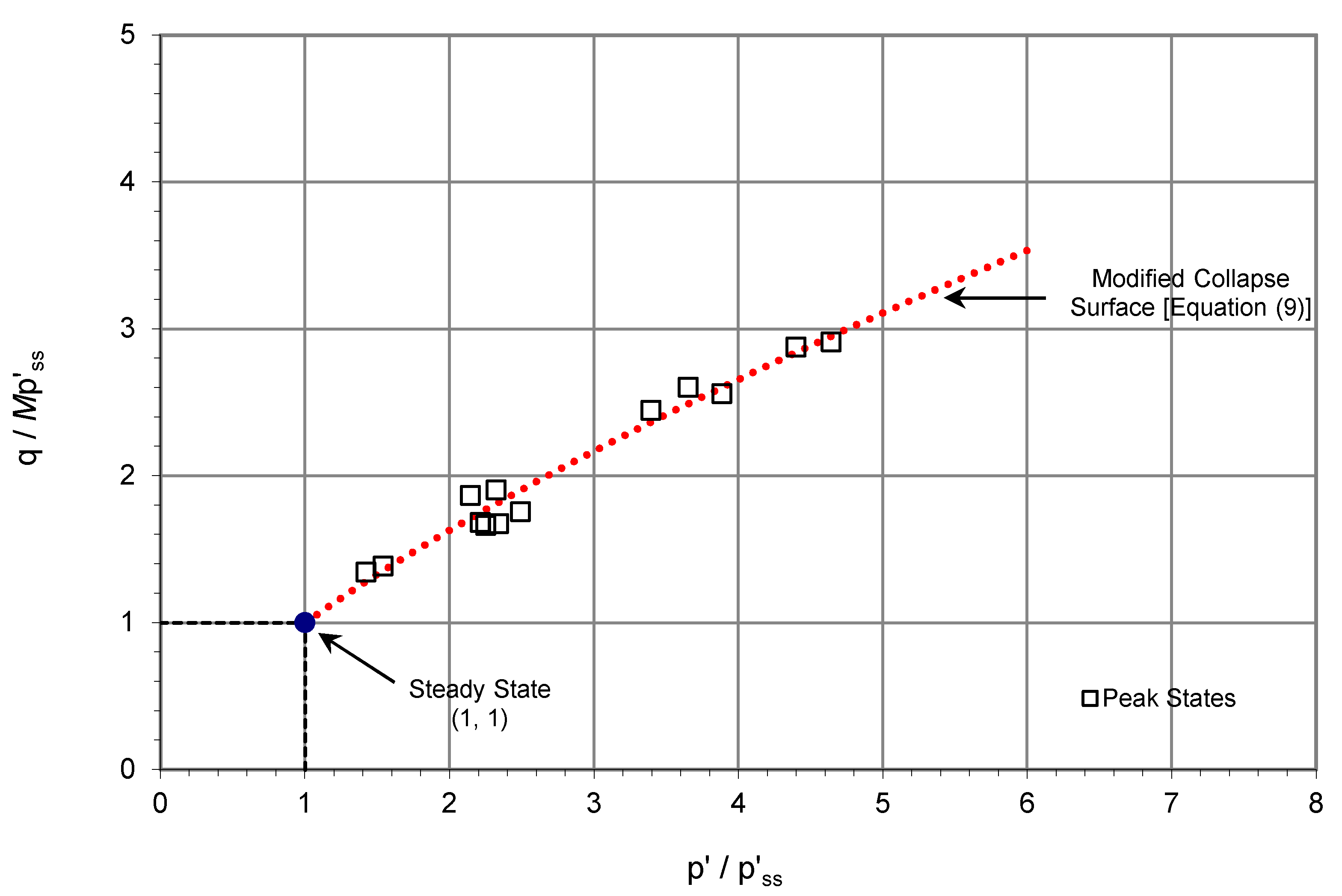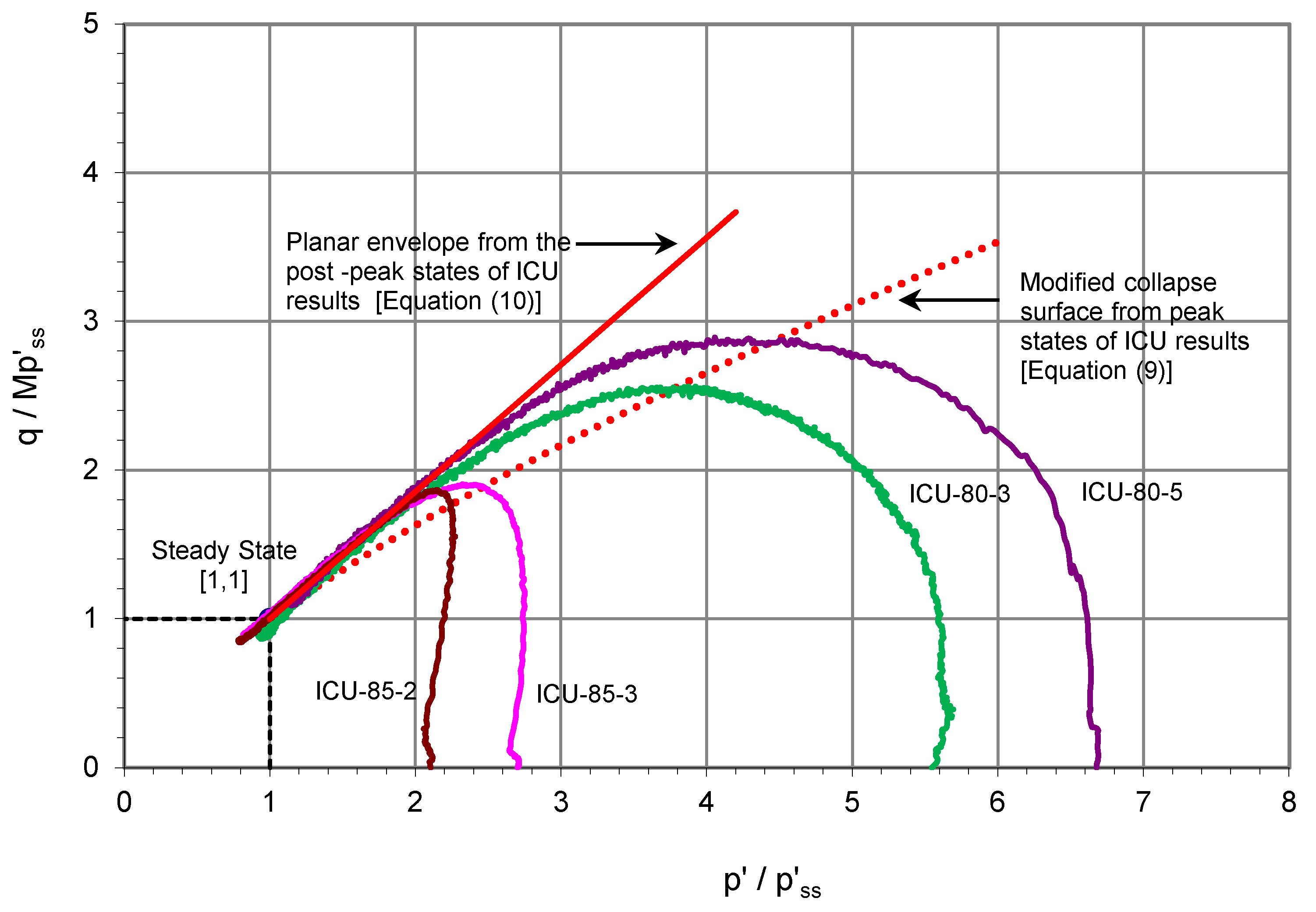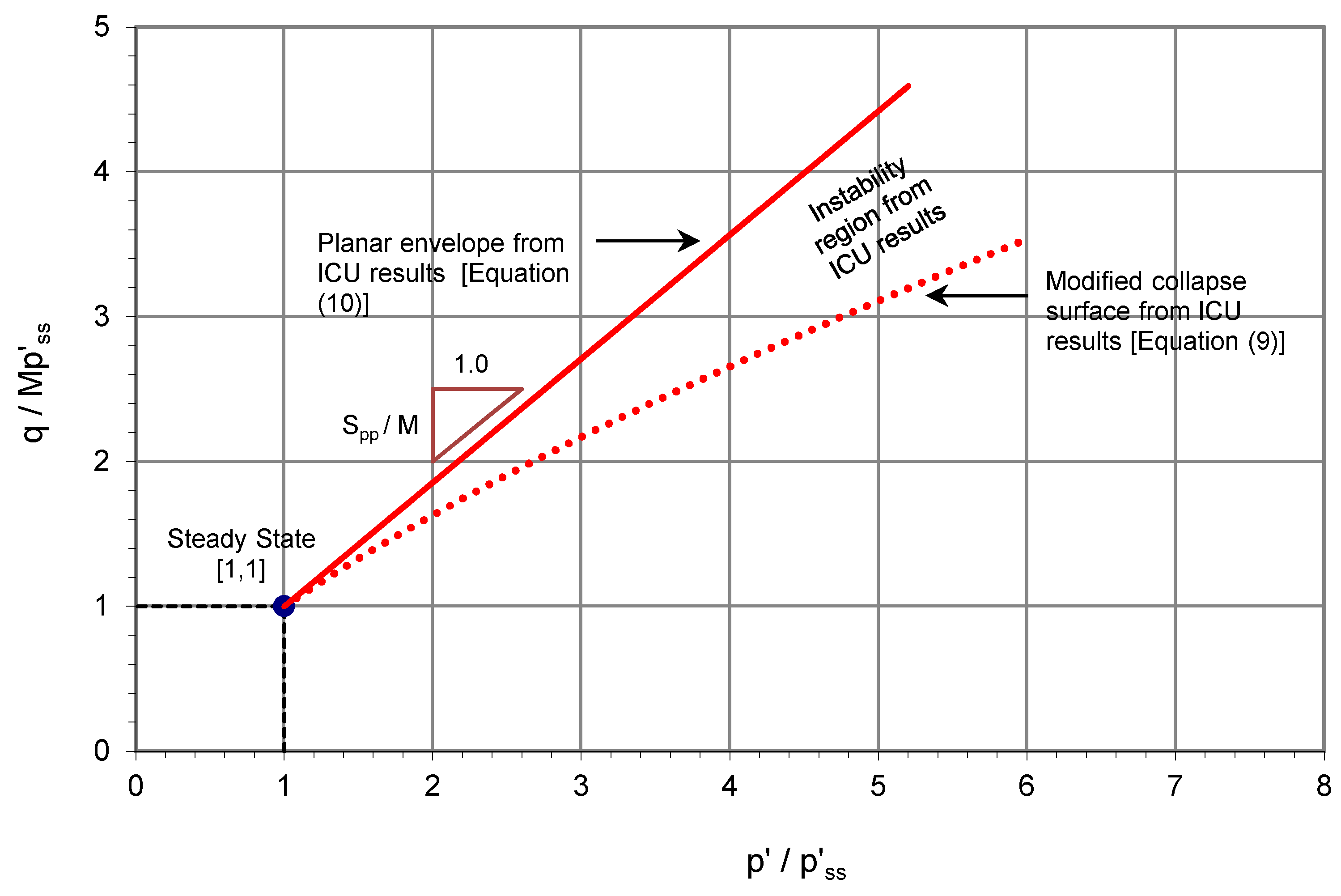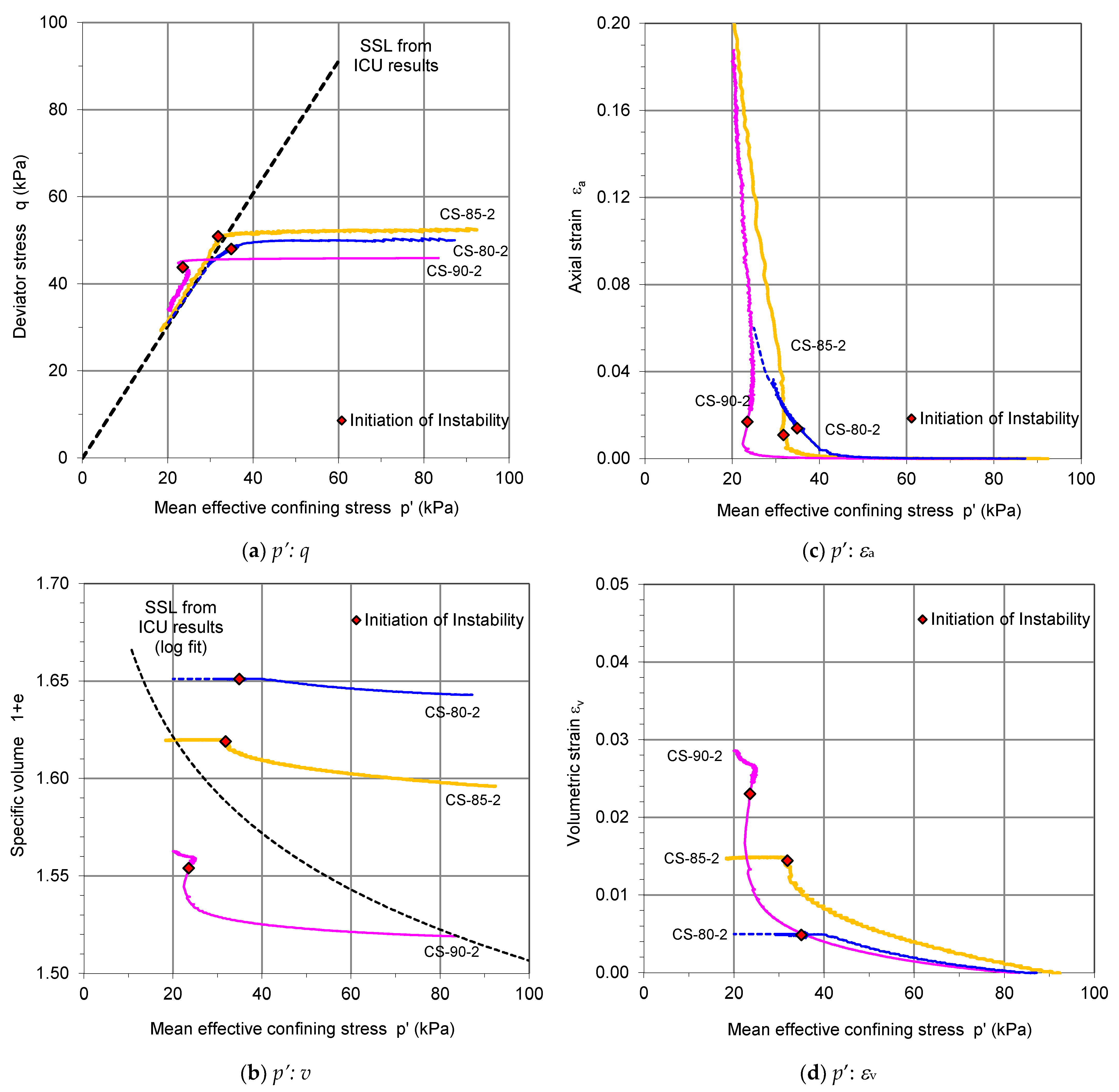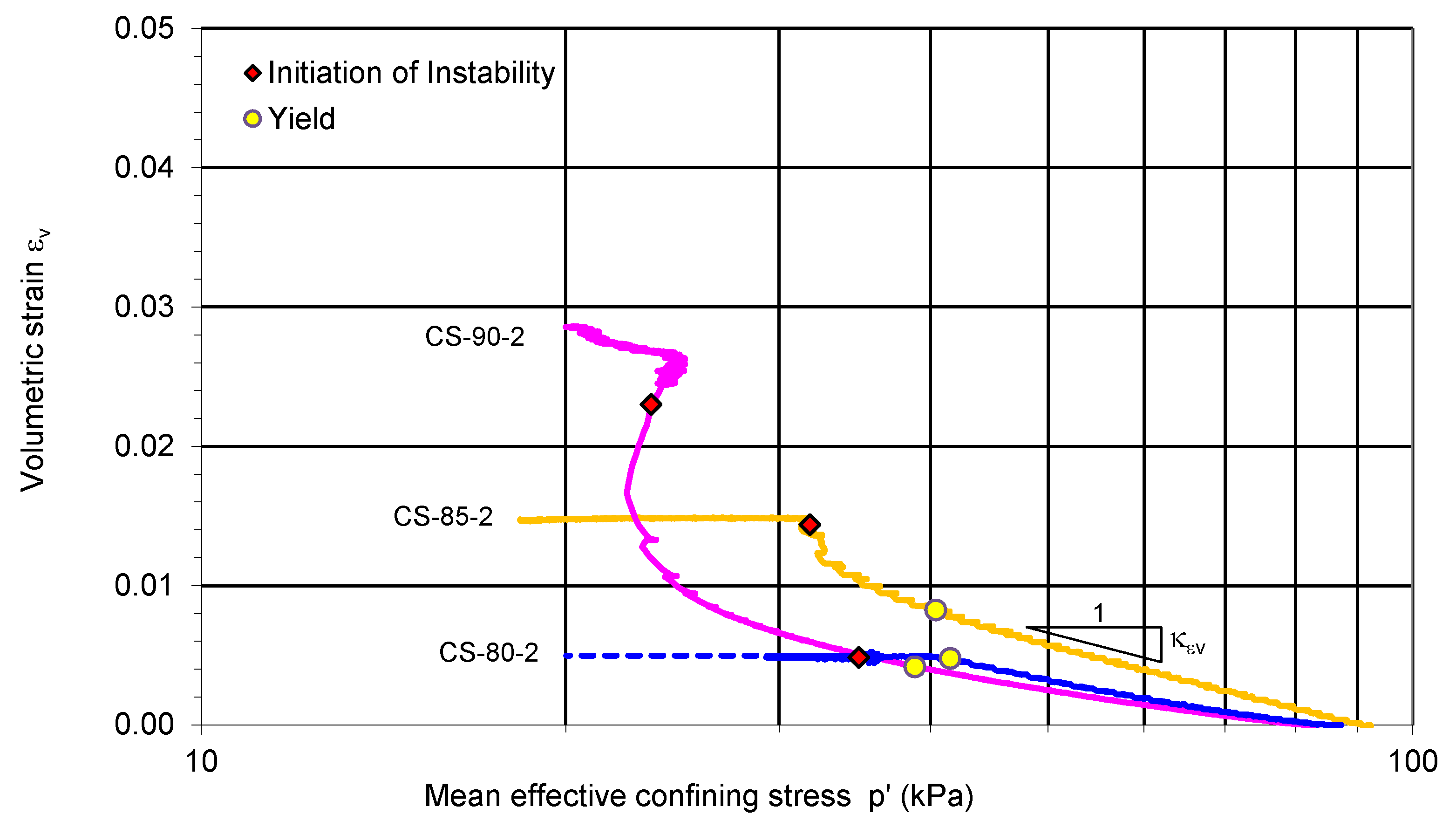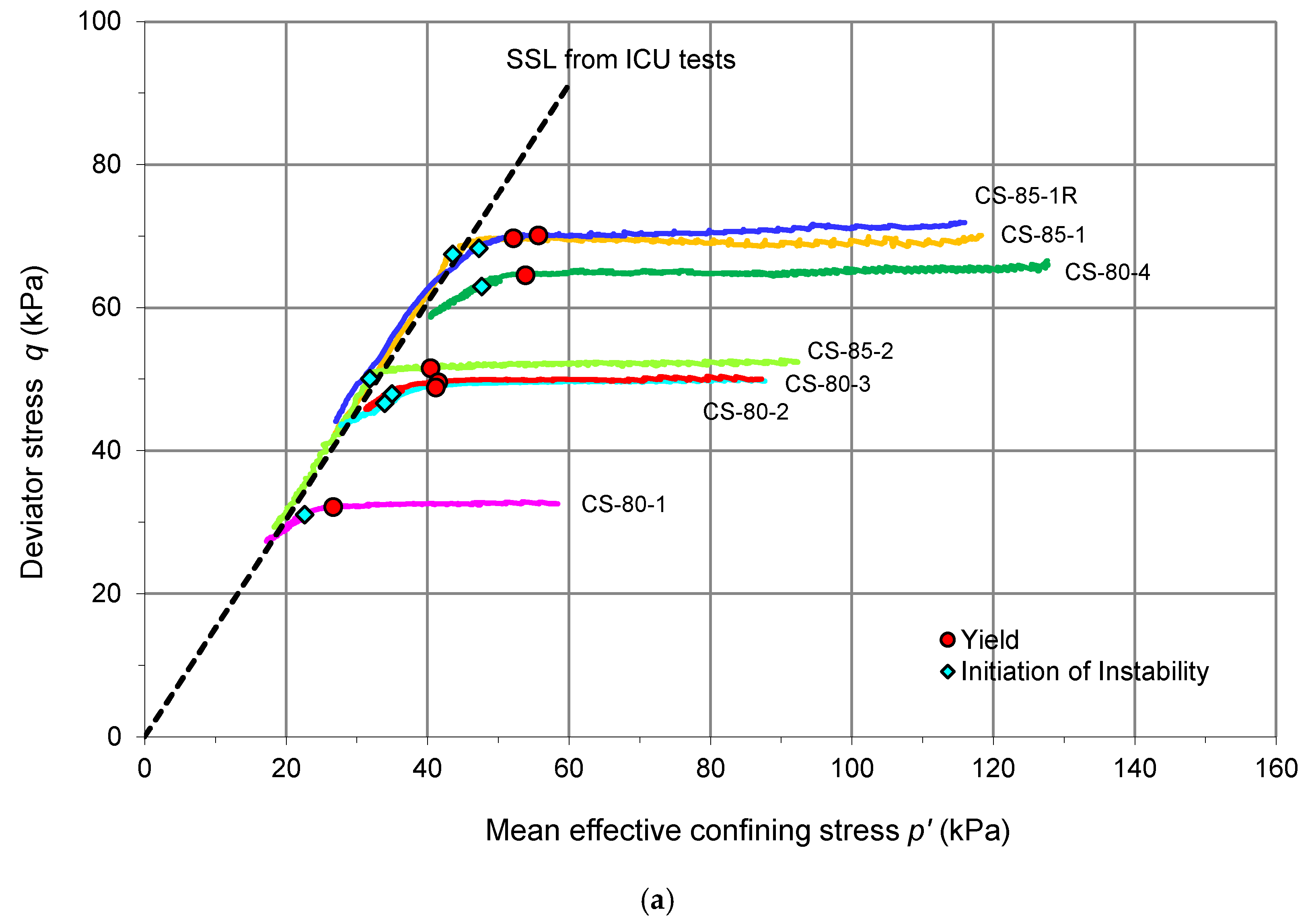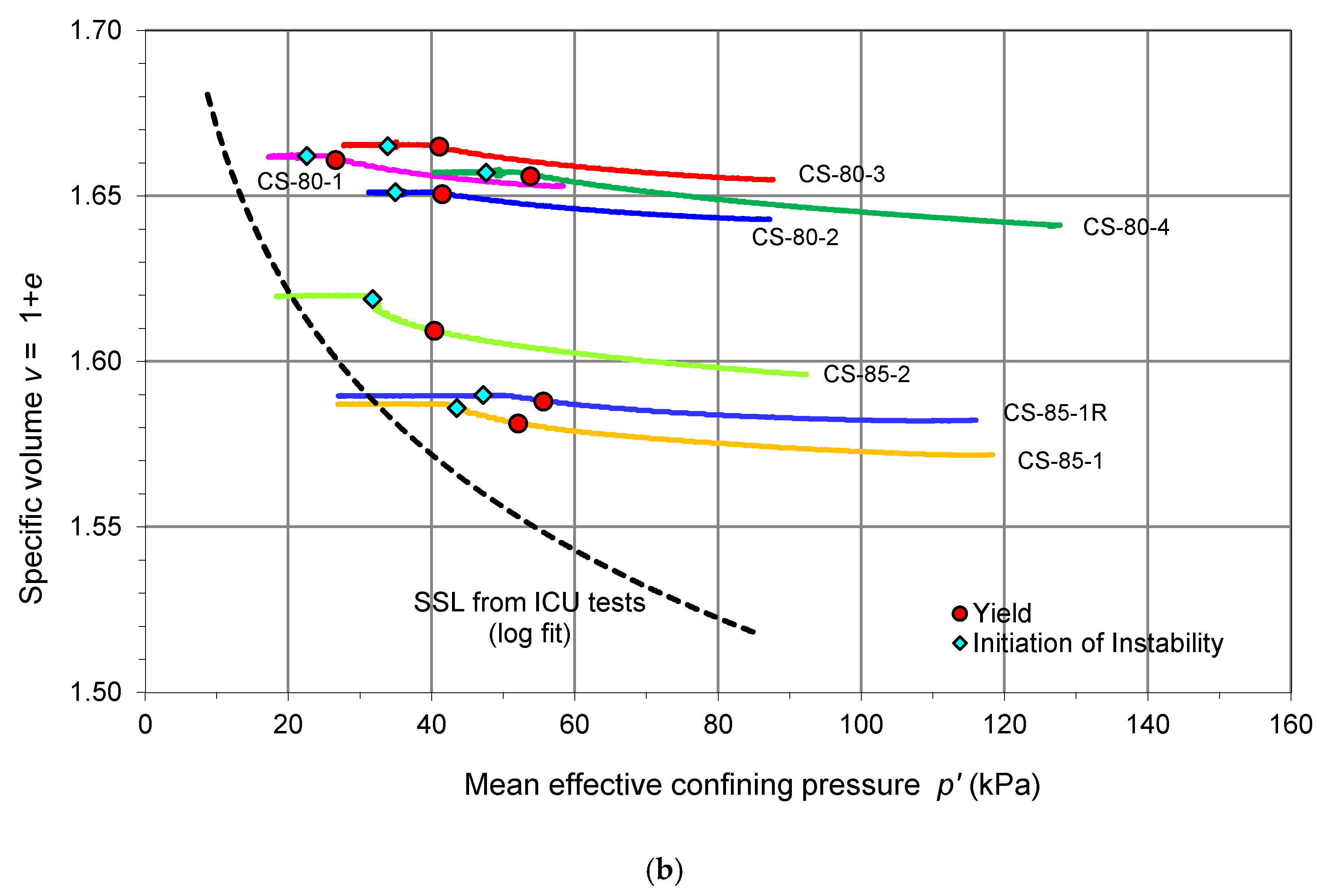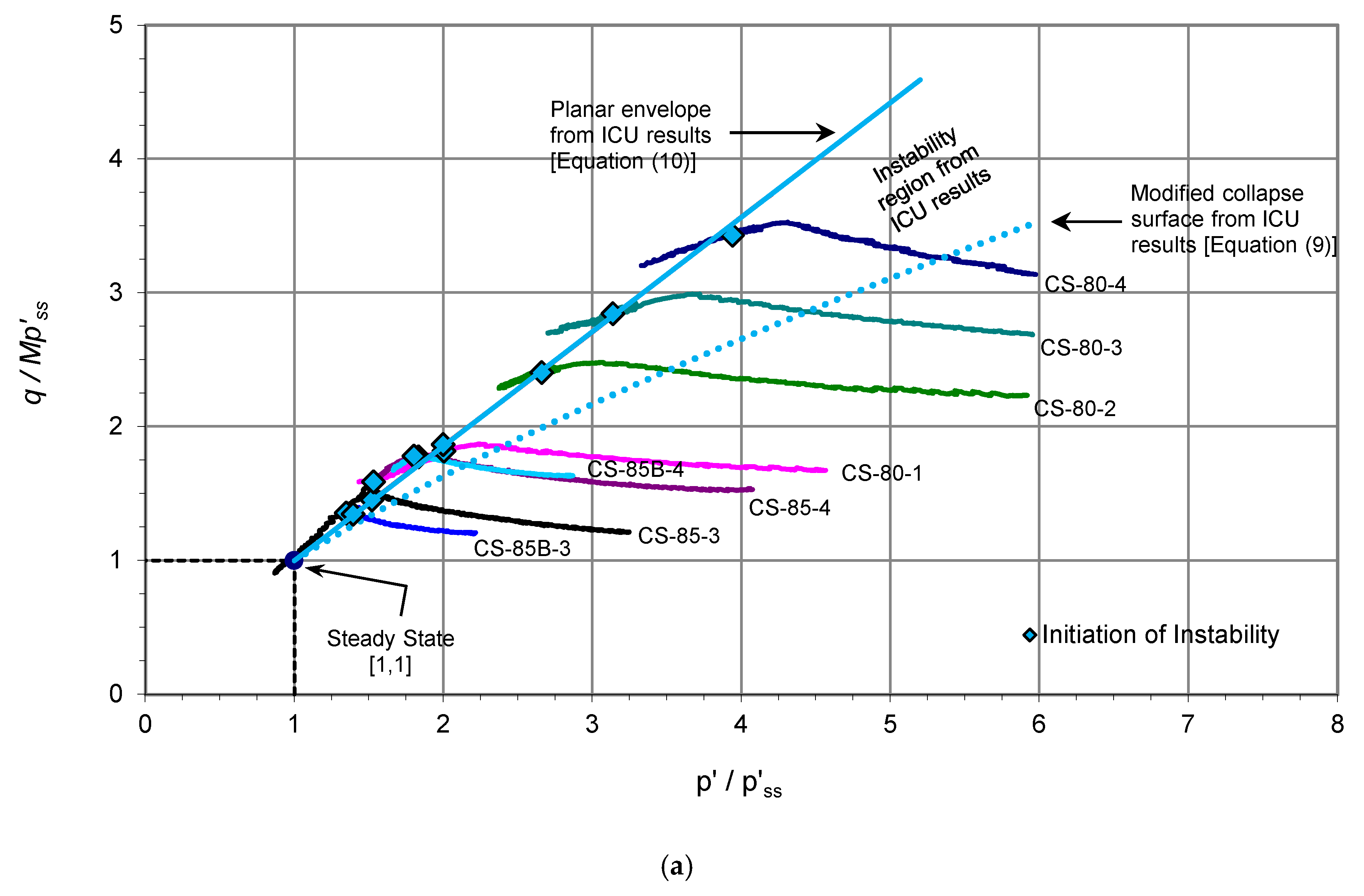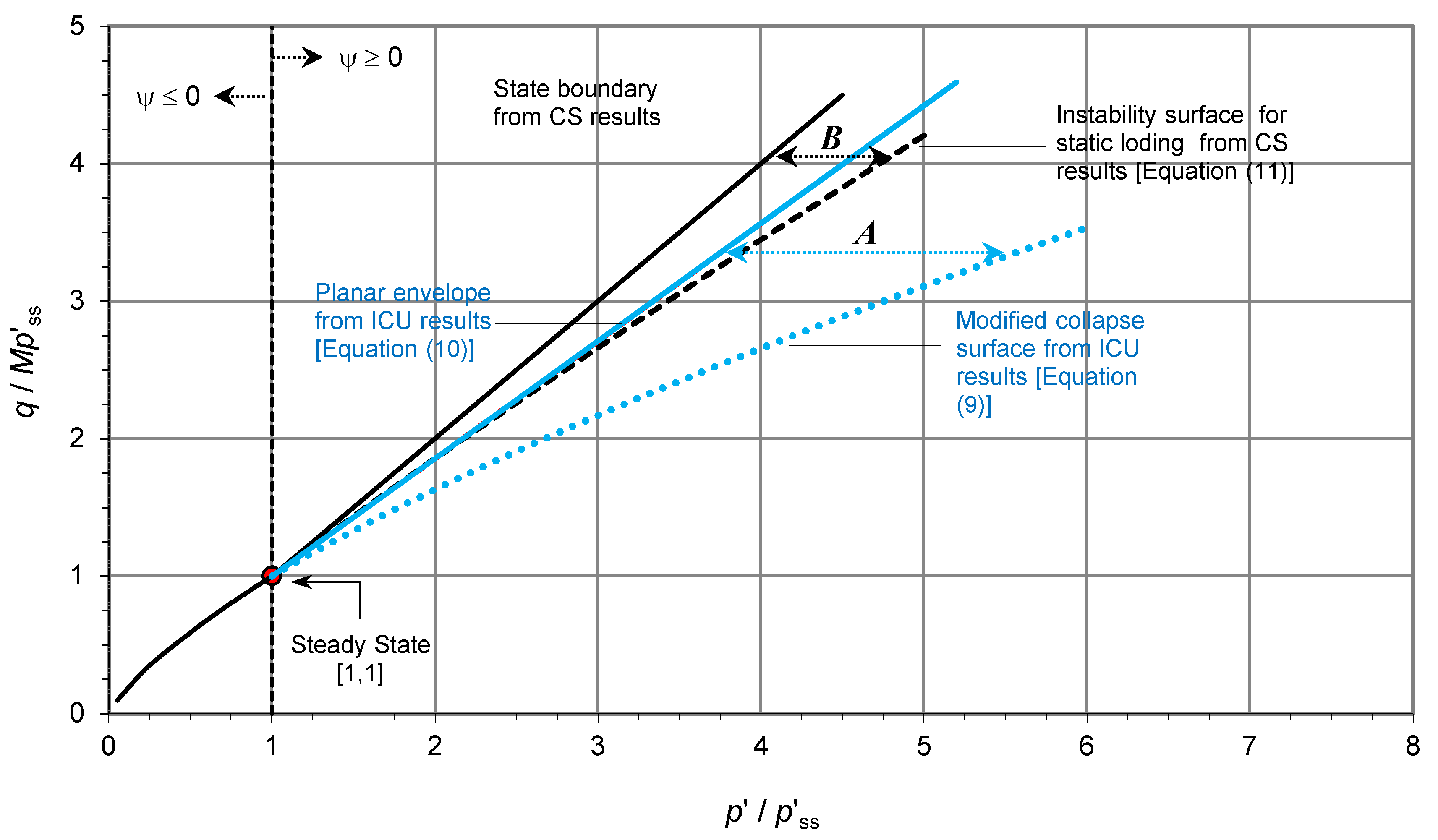1. Introduction
Liquefaction of loose saturated materials has been observed to initiate at a mobilized stress ratio well below the steady-state stress ratio [
1,
2,
3,
4]. Sladen et al. [
1] introduced the concept of the collapse surface in
p’: q: v space based on the peak states of undrained stress paths for the loose sand to explain the instability phenomenon. Sasitharan et al. [
5] proposed that the envelope composed of post-peak portions of the undrained stress paths for loose samples defines the state boundary in
p’: q: v space (above which no stress state can exist for the soil). Sasitharan et al. [
6] approximated the state boundary by a planar envelope passing through the steady-state line. They showed that liquefaction could be initiated when the stress paths for loose materials approach the state boundary surface in either drained or undrained loading.
The above collapse concepts of static liquefaction are largely based on the results of conventional undrained triaxial tests on loose sands. Most of the liquefaction failures in slopes are induced by the reduction in effective confining stress whilst shear stress remains nearly constant, as opposed to the failures reproduced by increasing shear stress in conventional triaxial tests. This difference was first noted by Bishop and Henkel [
7]. Brand [
8] emphasized that laboratory studies be focused on constant shear stress tests to closely simulate the field stress path.
This study investigated the instability of a compacted residual soil using isotropically consolidated undrained (ICU) and specially equipped constant shear (CS) triaxial tests on specimens of various densities. The parameters associated with the collapse surface concepts and steady states of the soil were obtained from the ICU tests. The CS tests were used to characterize the instability states in static loading and to examine the applicability of the existing collapse surface concepts for the compacted residual soil.
2. Experimental Program
A bulk sample of completely decomposed granite was taken from Beacon Hill in Hong Kong. Based on visual inspection, it was a sandy residual soil and yellowish-brown in color. The particle size distribution of the soil is shown in
Figure 1 and the index properties of the soil are summarized in
Table 1. According to the British classification system, the soil can be classified as well-graded, silty, gravelly sand. The results of the standard Proctor test indicated a maximum dry density
(γd(max)) of 1900 kg/m
3 and an optimum moisture content of 12.5%.
Four series of ICU tests were conducted on specimens prepared at void ratios corresponding to target relative compactions
Rc (
/
) ranging from 80% to 95%. The details of the test series are presented in
Table 2. For the CS tests, the target relative compactions (
Rc) ranged from 80% to 90%. The CS specimens were consolidated to two ranges of principal stress ratios,
/
. The lower stress range
/
varied from 1.6 to 1.8 and the upper range
/
was between 2.1 and 2.9.
Table 3 summarizes the details of the CS test program.
2.1. Testing Arrangement
Constant shear triaxial tests can be performed either by reducing the cell pressure while maintaining the back pressure and deviator stress or by increasing the back pressure while maintaining the cell pressure and deviator stress. The second method was used in this study. The triaxial setup consisted of a triaxial cell, a bladder air–water pressure cylinder, a stand-alone back pressure controller, a hanger straddling over the triaxial cell, a load frame, and a high-speed data acquisition system (
Figure 2). The hanger with dead weight was used for the CS tests and the load frame was used to apply strain-controlled displacement for ICU tests. The data acquisition system consisted of three pressure transducers, an internal submersible load cell, a volume change measurement device, an axial displacement transducer, an amplifier, and a computer with an analog-to-digital card.
The back pressure was controlled by the stand-alone back pressure controller. The cell pressure was maintained constant by the bladder air–water pressure cylinder connected to a pressure panel, which maintains the cell pressure even during any sudden failures in CS tests. The axial force applied to the specimen was measured by the submersible load cell. The pressure transducer connected to the top cap was used to record the back pressure applied to the specimen. The pressure transducer connected to the base pedestal was used to measure the pore pressure of the specimen and to assess the pore pressure distribution within the specimen by comparing the readings at its top and bottom, particularly during the failure stages of CS tests. The cell pressure was also measured throughout a test using another pressure transducer to ensure that the pressure maintained constant. The measurements of axial stresses and pore pressures were accurate to 2 kPa and 0.5 kPa, respectively.
The volume change measurement device attached to the back pressure channel was used to record the amount of water drained into or out of the specimen. The data acquisition system was capable of recording the signals from the three pressure transducers, the submersible load cell, volume change measurement device, and axial displacement transducer, at rates up to 1 kHz.
2.2. Test Procedures
Test specimens of 76 mm in diameter with a height-to-diameter ratio of 2 were formed by the moist-tamping method at the optimum moisture content. Each specimen was prepared to the desired sample density in a split mold in five layers. The specimen was then transferred to the triaxial base pedestal with a filter paper and a porous stone at each end, and then enclosed in a 0.3 mm-thick latex membrane. Measurements of sample dimensions were taken while maintaining a negative pore pressure of about 10 kPa. Saturation of the specimen was carried out by flushing with carbon dioxide followed with de-aired water, and applying back pressure. B values of 0.98 or higher were easily attained at a back pressure of less than 200 kPa. An effective pressure of 10 to 15 kPa was maintained during the saturation process. After saturation, the specimen was isotropically consolidated under a prescribed pressure. Back pressure was maintained at a value between 200 and 250 kPa during consolidation.
For the ICU tests, the drainage valve was closed after the consolidation stage, and the specimen was compressed in a strain-controlled manner at a strain rate of 0.08 mm/min. The measurements of axial load, axial deformation, and pore pressure were taken at one second intervals. The axial compression was continued until the deformation reached about 20% axial strain.
For the CS tests, the specimens were prepared and saturated in the same manner as for the ICU test specimens. The specimens were then isotropically consolidated to a predetermined value and deviator stress was applied under drained conditions by increasing the dead load on the hanger until the required stress ratio was reached. Back pressure was maintained at a value between 200 and 250 kPa during the whole period of the consolidation process. Once the required stress states were achieved, the specimen was subjected to the constant shear stress path by increasing the back pressure at a rate between 4 to 10 kPa/h. The tests were continued until axial deformation reached its limit. The data were acquired at 0.01 s intervals.
4. CS Test Results
For the CS tests, three sets of specimens prepared at different relative compactions were used (refer to
Table 3). Typical test results selected from each set (CS-80-2, CS-85-2, and CS-90-2) are presented in
Figure 10. These specimens were isotropically consolidated approximately to
p’ of 70 kPa and deviator stress was applied in a drained manner until the stress ratio (
q/p’)
ac reached a value of about 0.56. The void ratios of the specimens after the anisotropic consolidation were respectively 0.643, 0.596, and 0.519. In
Figure 10a–d, deviator stress
q, specific volume
v = 1 + e, axial strain
, and volumetric strain
are plotted against mean effective confining stress
p’. For the calculation of the volumetric and axial strains, the state after the anisotropic consolidation was considered as the initial state. Note that for CS-80-2 and CS-85-2, the initial states were well above the steady-state line in the
p’:
v plane, and for CS-90-2, the initial state lay on the steady-state line. For the details of the test results, readers can refer to Junaideen [
10,
20].
4.1. Initiation of Instability
For the CS tests, during the reduction in
p’, volumetric strain increased consistently, whereas the axial strain started to develop only after
p’ reduced below 50 kPa (
Figure 10c,d). Axial strain rate increased with deceasing
p’, which consequently resulted in instability of the soil specimens. The ‘initiation of instability’ is defined here using an axial strain vs. time curve: the state at which the curve deviates from the tangent drawn at 1% axial strain. For the tests shown in
Figure 10a–d, the initiation of instability occurred at an axial strain between 1% and 2%.
Subsequent to the initiation of instability, the specimens CS-80-2 and CS-85-2 experienced rapid deformation and a sudden increase in pore pressures. The pore pressure readings taken at both ends of each specimen were essentially the same even during the rapid deformation, indicating uniform pore pressure distribution along the height of the specimen. For the specimen CS-90-3, which had a higher density, the initiation of instability occurred only after the volumetric strain had increased substantially. The subsequent deformation was very slow compared to those of CS-80-2 and CS-85-2, causing a slight reduction in pore pressure with a clear indication of a dilative behavior of the specimen.
4.2. Mobilized Stress Ratios
The most significant observation in the CS test results is that the initiation of instability for the loose specimens, CS-80-2 and CS-85-2, did not occur at low stress ratios as expected (
Figure 10a). The mobilized stress ratios corresponding to the instability states were comparable to the steady-state stress ratios, while the associated soil states in the
p’:
v plane were still above the steady-state line (
Figure 10b). The dense specimen CS-90-2 mobilized a stress ratio that was higher than the steady-state stress ratio; and the initiation of instability occurred after the maximum stress ratio was mobilized (
Figure 10a).
4.3. Pre-Failure Instability vs. Post-Failure Instability
The initiation of instability in CS-80-2 and CS-85-2 corresponds to the ‘pre-failure instability’ state or ‘collapse’ state of the soil. The specimens could not sustain the current deviator stress and the instability led to large deformations. In the case of CS-90-2, the observed initiation of instability did not indicate such a ‘collapse’ of the specimen. In view of the fact that the phenomenon in ‘dense’ soils occurs after the failure line is reached, it is referred to as a ‘post-failure instability’ [
17].
4.4. Demarcation of Yield
Figure 11 shows the yield points demarcated for the CS results. The gradient
κεv of the linear portion of the curves in the
Ln p’:
εv plane can be transformed to the commonly used soil parameter
κ =
vac κεv, where
κ is the gradient of the unloading line in the
Ln p’:
v plane, and
vac is the specific volume of the specimen after anisotropic consolidation. The values of
κ are 0.011, 0.011, and 0.008, respectively, for CS-80-2, CS-85-2, and CS-90-2.
Figure 11 also indicates that between the yield state and initiation of instability, CS-90-2 exhibits significant dilation. CS-80-2 exhibits contraction, while CS-85-2 exhibits a certain degree of dilation before its initiation of instability.
4.5. Normalized CS Results and Comparison with ICU Results
A summary of all the CS test results is given in
Table 5.
Figure 12 shows the results of the specimens that experienced pre-failure instability in the CS tests and the steady-state line obtained from the ICU tests. The states of yield and initiation of instability in the CS tests are also shown.
The normalized stress paths for the CS test results are shown in
Figure 13a for
and
Figure 13b for
, where
is the mean effective confining stress at the steady-state line at the current specific volume. Note that different scales have been used for these two plots. For the ICU tests, the specific volume did not change and
remained the same during the test. For the CS tests, varying specific volume caused a decrease in
during the test. The modified collapse surface and the planar envelope obtained from ICU results are also shown in
Figure 13a. For clarity of presentation, not all the stress paths are shown in the figure.
The states
shown in
Figure 13b represent the soil states below the steady-state line in the
p’:
v plane. Note that the initial state of CS-90-3 was above the steady-state line in the
p’:
v plane, but subsequent reduction in the effective confining stress brought the stress state below the steady-state line in the
p’:
v plane. For all the specimens of the CS-90 series, instability occurred after they mobilized maximum stress ratios that are higher than the steady-state stress ratio. The corresponding stress paths at the higher stress ratios appeared to trace the state boundary for the dense states of the soil.
For the loose specimens, the unstable region deduced from the ICU results was confined by the modified collapse surface (Equation (9)) and planar envelope for the post-peak states of ICU results (Equation (10)), as shown in
Figure 13a. The CS results clearly show that each of the loose specimens experienced instability at a stress state falling far above the modified collapse surface. That means, before experiencing instability under the constant shear stress condition, the loose residual soil mobilized a stress ratio higher than that defined by the peak states of undrained loading. In some cases, the mobilized stress ratio was closer to the steady-state stress ratio. The results also showed that it is possible for loose soil states to exist even above the planar envelope.
4.6. Instability Surface for Static Loading
Considering the variation in the stress ratio mobilized at the initiation of instability in the CS tests with increasing density, an instability surface for static loading is postulated as a function of
, which uniquely defines the soil state in the
p’:
v plane.
Figure 14 presents the postulated surface as the lower bound for the initiation of instability states in the CS tests:
where
and subscript ‘s’ denotes
static loading or
constant shear path. With the maximum stress ratios reached in the CS tests, the state boundary is approximated to be a planar surface having a gradient of unity in
space, as shown in the figure.
5. Discussion
The present study allowed a systematic comparison of the results of the ICU tests and CS tests in
space in a unified manner. The instability surface and state boundary obtained from the CS results are shown in
Figure 15 together with the modified collapse surface and the planar envelope of the ICU results. In the figure, the instability regions obtained from the ICU and CS results are denoted by
A and
B, respectively. The instability region
B for static loading fell almost entirely above the instability region
A for undrained loading.
The modified collapse surface defined by the peak states of undrained loading (Equation (9)) and the instability surface for static loading (Equation (11)) can be represented in a same form,
where
=
= 0.706 for the modified collapse surface, and
=
= 0.892 for the instability surface. The maximum stress ratio attained along the surfaces can be obtained as a function of state parameter. From Equation (12),
From Equations (13) and (14), the maximum stress ratio can be obtained as,
For a particular soil state (or state parameter), the maximum stress ratio depends on parameter . The value of is smaller for the modified collapse surface than for the instability surface. Therefore, liquefaction analysis based on the normally used collapse surface would provide over-conservative results for the residual soil.
The planar ICU envelope was proposed by [
6] as the state boundary for ‘very loose’ sands. Although the planar envelope does not serve as the state boundary for the loose residual soil, it coincides with the instability surface for
. It would therefore be of interest if the planar envelope can be related to the state parameter. From Equation (10),
From Equations (14) and (16),
The maximum stress ratio attained along the planar envelope is
Accordingly, the effect of state parameter on the maximum stress ratio will become insignificant when the magnitude of the state parameter becomes high. Nevertheless, the maximum stress ratio attained along the instability surface (Equation (15)) will consistently decrease with state parameter.
Figure 15 also shows that the difference between the planar ICU envelope and instability surface becomes larger at higher stress levels.
It should be noted that the planar ICU envelope is just an approximation to the envelope composed of the post-peak portions of the undrained effective paths. It is also possible that the exact nature of the envelope is curvilinear and, in that case, it could coincide with the instability surface. Nevertheless, it is not always viable to obtain a curvilinear envelope from undrained stress paths. Therefore, with the present findings, if the instability surface can be deduced from the normally used planar envelope of undrained stress paths, it would be of use. By equating the gradient of Equation (10) to the secant gradient of Equation (11) with respect to the steady state, the following relationship can be obtained,
where
Spp is the slope of the planar ICU envelope, and
is the parameter deduced from ICU results for the instability surface of static loading. From Equation (19),
By substituting the soil parameters
M = 1.52 and
Spp = 1.30 in Equation (20), it can be derived as 0.855 <
< 0.901 for 1.0 <
< 2.5. Sladen et al. [
1] suggested that the ‘very loose’ state corresponds to a
value of 2 or greater for isotropically consolidated samples. The value of
becomes 0.892 at
= 2. This value coincides with the constant obtained for the instability surface from the CS test results. It is therefore reasonable to use the limiting condition of
= 2 to calculate the value of
.
The above method of deducing the instability surface for static loading can be summarized as follows: (1) the parameters M, Γ, λ, and Spp are obtained from conventional undrained test results; (2) the parameter is estimated from Equation (20) using the limiting condition of = 2; and (3) the value of is substituted in Equation (11) to obtain the instability surface for static loading. As this instability surface is defined for soil states with ≥ 0, it can be used in a unified manner for ‘very loose’ and ‘slightly loose’ materials.
6. Conclusions
Instability behavior of a compacted residual soil was investigated using a series of conventional isotropically consolidated undrained triaxial tests and a series of specially equipped constant shear stress triaxial tests. The test results were characterized by the current state parameter defined in the p’: v plane with respect to the steady-state line for the residual soil.
Instability states demarcated by the peak states of the undrained triaxial tests varied with specific volume and stress level. A modified collapse surface representing the instability states of undrained loading in the p’: q: v space was proposed. Unlike the normally used collapse surface for loose sands, which has a constant gradient in the p’: q plane, the modified collapse surface for the residual soil had a gradient varying with stress levels and specific volumes.
Constant shear stress tests, which closely simulate the static loading condition, showed that before experiencing instability, the loose residual soil can mobilize stress ratios higher than the corresponding ratios defined by the modified collapse surface. A curvilinear instability surface in the p’: q: v space was proposed for the instability states reached in static loading. Further, an alternative method of deducing the instability surface for static loading from the planar envelope of the undrained stress paths was presented.
As the modified collapse surface representing the instability states of undrained loading and the instability surface representing the instability states reached in static loading are directly related to the current state parameter and mean confining stress, instability analysis for the residual soils can be performed in a unified manner.
